Hip Arthroscopy
Austin Cole, MD, provides nonsurgical treatment, minimally invasive surgery, and open surgery for various hip joint conditions. He is uniquely trained in hip arthroscopy and endoscopy to treat injuries and pathologies around the hip. A range of problems may occur in or around the hip joint other than arthritis. Recent advances in orthopedics and minimally invasive arthroscopy have led to updated treatment options for these conditions. Many call these treatments and surgeries 'hip preservation.'
Dr. Cole is the only surgeon in the state of Arkansas who regularly utilizes Stryker HipCheck intraoperatively. HipCheck is cutting-edge software that allows surgeons to measure and resect bone for hip impingement precisely. This computer-aided system allows real-time feedback during surgery to guide surgeons in reshaping bone to normal contours, minimizing residual pain, and ensuring the best outcomes. He also uses HipMap, when necessary, to preoperatively plan complex cases through 3D imagery. To learn more about Dr. Cole, view his profile.
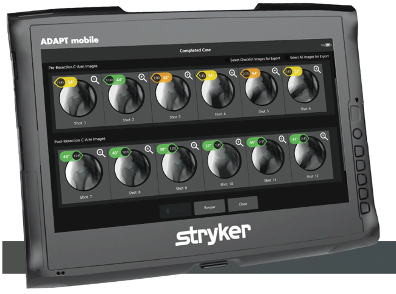

Conditions Dr. Cole Treats
- Femoroacetabular impingement (hip impingement)
- Labral tears
- lGuteal tears
- Snapping hip
- Hamstring tears
- Core Muscle Injury (Sports Hernia)
- Hip Bursitis
What is Hip Arthroscopy?
Hip arthroscopy is a minimally invasive surgical technique for diagnosing and treating various injuries or disorders of the hip joint. Unlike open surgery, which requires a large incision, arthroscopic surgery (in the joint) and endoscopic surgery (outside the joint) involve only a few small incisions. In most cases, patients can go home the day of the surgery. Recovery is typically faster than with open procedures. The most commonly treated conditions are femoroacetabular (hip impingement) and labral tears. However, this technique may treat many other conditions in and around the hip.
Do I Need Surgery?
There are many nonsurgical treatments available to help relieve hip pain. Most patients improve through these conservative measures and do not require surgery. A large percentage of people have labral tears or gluteal tears and are not even aware of them. Others may be symptomatic. There are various reasons, including individual anatomy, activity level, tear size, the body’s accommodation, and more. This may include activity modification, physical therapy, home exercise programs, anti-inflammatory medications, and injections. If a patient fails these measures and continues to experience persistent symptoms that affect activity and daily life, and is considered an appropriate candidate, arthroscopic surgery may be a valuable option.
What is Femoral Acetabular Impingement (FAI)?
Impingement occurs when the ball-shaped head of the femur rubs abnormally or pinches (impinges) the acetabular socket. Damage to the hip joint can occur to the articular or labral cartilage.

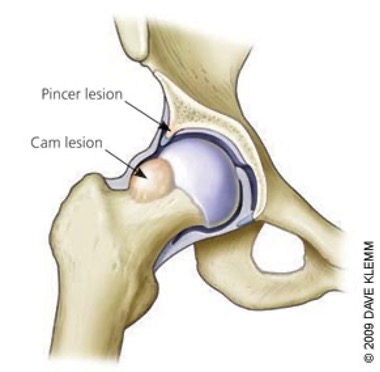
What types of FAI are there?
There are three types of FAI. The first involves an excess of bone along the neck of the proximal femur: this is known as a Cam deformity. The second is due to an excessively deep socket or an abnormal tilt of the acetabular socket, which is known as the Pincer deformity. The third mixture of the preceding two forms, the most common scenario. Any of these deformities results in increased friction between the acetabular cup and femoral head, which may result in pain and reduced hip function.

What is a labral tear?
The acetabular labrum is a fibrous structure that forms a gasket seal around the femoral head. The labrum may be damaged or torn as part of an underlying process, such as FAI, or may be injured directly by a traumatic event. Damage to the labrum can produce either groin pain or pain in the distribution of a “C” around the hip joint. If left untreated, both FAI and labral tears may progress to arthritis of the hip joint, requiring a total hip replacement.
Evaluation for labral tear
The labrum is typically evaluated using advanced imaging, such as an MRI arthrogram, which includes an injection of contrast directly into the hip joint. The injection of contrast aids in the diagnosis of labral injury.
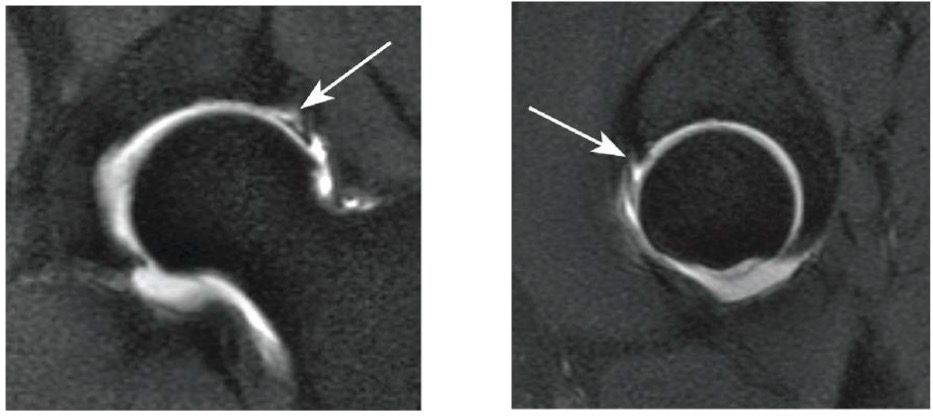
The arrows in the above picture highlight an anterior-superior labral tear. The bright white area in the images is the MRI contrast or fluid from the injection. The arrows indicate an area where contrast between the labrum and the acetabulum suggests a tear.
An MRI may also measure the severity of bony abnormalities in FAI. This defect is often described as the hip's alpha angle. The alpha angle helps to determine the size of cam impingement; the larger the alpha angle, the larger the cam impingement lesion (generally > 50 to 55 degrees indicates a cam lesion).
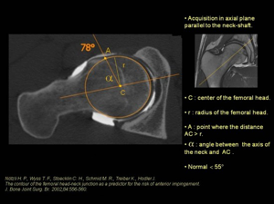
How is FAI and/or a labral tear treated?
Non-operative treatment options include formal physical therapy, activity modification, and steroid injections, which may lead to a decrease in pain and improved function. Surgical intervention may become necessary depending on the patient's activity and lifestyle demands. In the past, FAI and labral repairs were performed open surgically. Advancements in arthroscopic techniques have recently become available that can repair the acetabular labrum and treat FAI while minimizing the patient's surgical morbidity.
Intra-operative fluoroscopy (live x-ray) allows precise placement of arthroscopic portals and a determination of the amount of bony resection necessary to fully treat the underlying condition of the hip. Using 2 to 4 portals, with and without traction on the hip joint, the surgeon can access different regions of the hip joint. This allows the surgeon to treat both cam and pincer impingement, fix or even reconstruct labral tears, fully evaluate and treat conditions affecting the joint lining of the hip, and even repair instability cases in the hip.


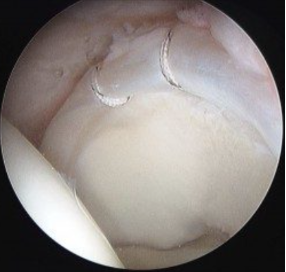
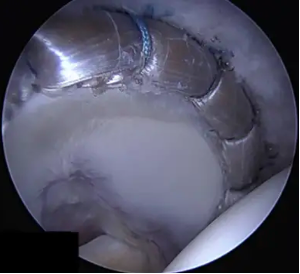
Top-left: Example of a labral tear
Top-right: Intra-operative fluoroscopy showing an arthroscopic camera and burr used to correct a Cam Deformity
Bottom-left: Example of a labral repair
Bottom-right: Example of a labral reconstruction
The Results
A recent study by Dean Matzuda compared traditional open surgery versus arthroscopic hip surgery and found, "The arthroscopic method had surgical outcomes equal to or better than the other methods with a lower rate of major complications when performed by experienced surgeons."
Although hip arthroscopy is a relatively new field, a 10-year follow-up study on 50 patients by Dr. Thomas Byrd found 87% return to sport with an improvement in the Harris Hip score of 45 points (51 to 96 on a 100-point scale). Other studies have found return to sport to be at an average of 6 months postoperatively. Additionally, a 2023 study by Dr. Bruce Levy following 957 patients for nearly 13 years found a decreased risk of osteoarthritis and need for total hip arthroplasty in those treated with hip arthroscopy for impingement. A recent 2023 meta-analysis of 74 studies (over 213,000 patients) from the Orthopaedic Journal of Sports Medicine found significant improvement at all follow-up times (1, 2, and 5 years) in patients who underwent hip arthroscopy for femoroacetabular impingement.
Case example Patient
A 22-year-old female collegiate soccer goalie dove to her left to make another spectacular save in the closing minutes of the championship game to preserve a 1-0 shutout victory. As she got up to celebrate the victory, she noticed a sharp pain in her left groin and hip. Over the next few days, the acute pain slowly resolved, but she continued to have a "popping" sensation with hip flexion activities and an underlying dull ache.
A week's worth of post-injury rest and treatment with analgesics, ice packs, and soothing heat proved ineffective. The woman's athletic trainer and primary-care doctor agreed she needed to be evaluated by an orthopedic specialist. They referred her to a hip arthroscopy specialist for the highest level of care.
Her history, physical examination, and x-rays all pointed to an injury to the cartilage lip around the hip socket called the labrum. An MRI arthrogram confirmed this diagnosis, as well as a predisposing condition called femoral acetabular impingement (FAI).
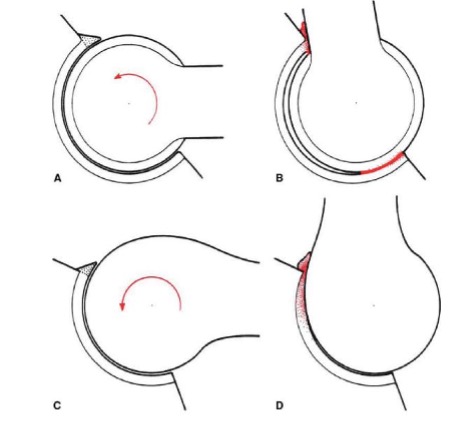
(A) and (B) Normal hip - there is greater range of motion (or hip flexion) required to cause collision or impingement between the femoral neck and the acetabulum.
(C) and (D) CAM lesion & labral pinching present.
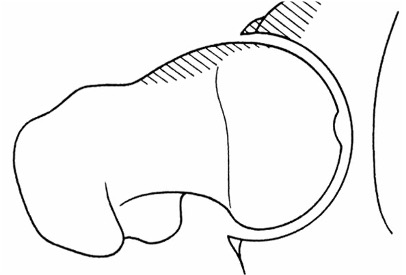
(A) and (B) X-rays demonstrating right hip FAI.
(C) MRI showing combined FAI and labral tear.

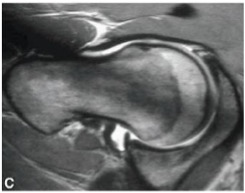
Treatment plan:
After a course of non-operative treatment, including formal supervised physical therapy, proved to be ineffective, the patient elected to proceed with surgical intervention. A minimally invasive hip arthroscopy was offered to treat both the labral tear and the underlying bony femoral acetabular impingement. The underlying bony impingement needed to be addressed simultaneously because its presence would leave the patient vulnerable to re-injury of the hip labrum, persistent pain, and potentially progression to hip arthritis. The two repairs were scheduled to be performed during the planned operation.
The procedure began with a discussion with the anesthesiologist about potentially utilizing a one-time regional anesthetic called a "block" to decrease post-operative discomfort. She elected to proceed with a combined general anesthetic and a block. The patient was then brought to the operating room, positioned on a well-padded table, and went to sleep. The hip arthroscopy began with distending the joint with gentle traction. Through a series of "poke" holes (incision sites), a pencil-sized camera and equipment entered the hip joint. This allowed the labral tear to be repaired and the bony overgrowth along both the rim of the socket and the femoral head to be removed, thereby restoring her normal anatomy. She recovered from anesthesia without difficulty and felt well enough in the recovery area to be discharged home the same day following surgery.
Careful post-operative care, including early range of motion and a closely supervised physical therapy regimen, was essential to her recovery. By the next season, she had returned to the field to lead her team in defending their national title.
Post-operative protocol:
The initial phase of rehab (first 6 weeks) protects the repair and works on improving range of motion. Patients will be placed on crutches with restricted weight-bearing for 2 to 6 weeks, depending on what was performed during surgery. Inclusion of a stationary bike can occur as soon as the patient acquires an adequate range of motion (typically within the first 2 weeks). Swimming can be initiated as early as 3 weeks. By 6 weeks, patients usually have a normal gait without a limp for intermediate distances.
The second rehab phase focuses on regaining full range of motion and strength. At three months, patients begin functional activities (early sport-specific training and drills) with therapy supervision. If they have regained full strength, endurance, and range of motion, they can return to sport within 4 to 6 months. Improvement of patient outcomes may continue over the first year after surgery.


